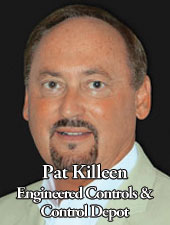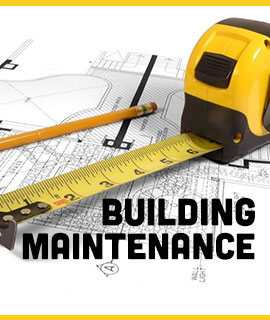Spring is right around the corner, but even if you don’t have any plans for construction, remodeling, or major projects to your building there are still other arrangements you should be mapping out for the year–and even well into the future. Setting up a schedule for proper building maintenance in the necessary intervals at the beginning of each year will ensure that your building is always at its best and will stand the test of time and traffic.
Maintaining a Solid Foundation
The structure of your building itself—or effectively the “bones” of your building—is a good place to start, and there are some major checkpoints and regular maintenance requirements that all property owners and managers should be aware of.
 “Primarily what we deal with at McGill Restoration is exterior work, and my recommendation for building owners and property managers is to regularly assess joint sealants around all window penetrations and door openings,” advises Darin Cielocha of McGill Restoration. “Furthermore, checking the control joints on any masonry at specific intervals is important too. These are prime examples of items that aren’t designed to last forever. A simple rule that applies to concrete is that eventually it will crack, so plan accordingly. The materials used to construct your building were made to be tough and to withstand the forces placed on them as well as environmental factors, but just about every component of a building will eventually wear out and need to be either restored or replaced. A building’s joints are made to absorb the differential movement between two materials, so naturally they are something to be assessed regularly—we recommend checking them every 5-7 years. Another simple rule of thumb is that anytime you put on a coating of anything—whether its paint, protective, etc.—at some point in time it will need to be recoated. This may be due to normal wear and tear, expansion or exposure to the elements, especially from fading due to ultraviolet light. Brick and block structures are especially nice because they are more durable than many of their counterparts, but they will also need to be assessed into their 3rd or 4th decade.
“Primarily what we deal with at McGill Restoration is exterior work, and my recommendation for building owners and property managers is to regularly assess joint sealants around all window penetrations and door openings,” advises Darin Cielocha of McGill Restoration. “Furthermore, checking the control joints on any masonry at specific intervals is important too. These are prime examples of items that aren’t designed to last forever. A simple rule that applies to concrete is that eventually it will crack, so plan accordingly. The materials used to construct your building were made to be tough and to withstand the forces placed on them as well as environmental factors, but just about every component of a building will eventually wear out and need to be either restored or replaced. A building’s joints are made to absorb the differential movement between two materials, so naturally they are something to be assessed regularly—we recommend checking them every 5-7 years. Another simple rule of thumb is that anytime you put on a coating of anything—whether its paint, protective, etc.—at some point in time it will need to be recoated. This may be due to normal wear and tear, expansion or exposure to the elements, especially from fading due to ultraviolet light. Brick and block structures are especially nice because they are more durable than many of their counterparts, but they will also need to be assessed into their 3rd or 4th decade.
Generally if you assess the necessary checkpoints every 5-7 years and then plan and budget accordingly to approach and correct the issues as recommended you’ll be in great shape. This will give you a baseline from which to formulate your maintenance schedule, and then you can factor everything into it by frequency—weekly, monthly, annually, every 5 years, every 10 years and so on. There should at minimum be some attention paid to building maintenance every year though. Your building is one of your biggest assets, and even if you plan to take on a little at a time it will make a big difference while everything also remains manageable—always think proactively. Once you’ve set your budget, it is also important to stick to it. As a rule of thumb you should spend at least 1% of the total value of your building on its maintenance each year.”
He adds, “Our expertise allows us to forecast items you should be concerned about short term and long term by testing certain things, so we can always be of assistance in giving property owners an honest assessment of where they are currently and what they will be looking at down the line. It is important to understand that small problems with your building will never present themselves and then just go away, but they will compound if not corrected. We check for the things that you don’t see.
Restoration is crucial because of its concern with preservation; every city and town has a skyline that tells its past. It is a major act of sustainability too, as you’re not tearing down something and putting something new in its place. As restoration specialists, we look at everything from the perspective of preservation. We specialize in removing years of muck and correcting any deterioration or issues so that you can keep the historically accurate look of the building while improving it to functionally just as good as new.”
Maintaining an Optimal Working Environment
It’s important to keep in mind that a lot of items that should be included on your building maintenance checklist are things that you’d only notice if they weren’t being done properly—cleaning is definitely one of those. Professional cleaning services will keep your building looking presentable at all times, which is exactly the environment you want to create for both your employees and clients. Furthermore, these professionals will also be able to tailor their services to your building’s specific needs and alert you of any issues they notice during their regularly scheduled visits.
 “ServiceMaster Professional Building Maintenance (PBM) provides comprehensive services which encompass all aspects of a facility,” emphasizes Jon Paolini of Service Master PBM. “Among the jobs our company is generally tasked with, floor maintenance is the most often overlooked area we run into. It is important for both carpeting and hard floors to follow at minimum the manufacturer’s guidelines for routine maintenance. Waiting until it ‘looks dirty’ to have flooring maintained will reduce its useful life and therefore it will need replacement sooner. We tailor routine maintenance schedules for flooring to prolong the life of the flooring as well as provide for its best possible appearance over its life.
“ServiceMaster Professional Building Maintenance (PBM) provides comprehensive services which encompass all aspects of a facility,” emphasizes Jon Paolini of Service Master PBM. “Among the jobs our company is generally tasked with, floor maintenance is the most often overlooked area we run into. It is important for both carpeting and hard floors to follow at minimum the manufacturer’s guidelines for routine maintenance. Waiting until it ‘looks dirty’ to have flooring maintained will reduce its useful life and therefore it will need replacement sooner. We tailor routine maintenance schedules for flooring to prolong the life of the flooring as well as provide for its best possible appearance over its life.
The maintenance schedule for flooring depends on flooring type and manufacturers guidelines, and if you don’t have the guidelines anymore they can usually be found online or by consulting a professional. We see so many floors we can typically tell you the recommendations of most any flooring. If you don’t follow the guidelines it can also void the warranty of your flooring in some cases, which of course leads to a problem if there is an issue with the flooring down the road. These maintenance programs don’t typically cost much in comparison to the cost of the flooring, especially when considering the added benefit of nicer looking floors throughout the life of the flooring. The last few years have also seen a much better variety and quality of ‘green’ products for flooring maintenance. We offer a full line of green options which don’t cost any more than traditional services.”
 Waste removal is also a very important part of maintaining a safe and pleasant working environment. “We feel maintenance is especially important when it comes to your liquid waste whether it be for your residence or your business,” emphasizes Jason Kubik, owner of Southwick Liquid Waste. “We offer maintenance programs for all types of properties, both commercial and residential, and here’s why our maintenance is such a big deal: When your septic system or grease trap backs up on you, typically that leads to other expense and problems. For instance, if a property owner or manager doesn’t maintain their septic system and it backs up into their facility they are then faced with 1) Not being able to use the bathroom or other activities that involve using water until the system is worked on and 2) Possible messes in the facility that are anything but clean. Liquid waste backing up into your place of business is never good and many times owners then have to pay to have carpets and furniture cleaned because they didn’t maintain their system. For grease trap owners, there are similar problems, but when they can’t use their kitchen efficiently that costs them money in possible revenue and fixing their back-up issues. When your heater goes out you’re cold and it will cost you money to replace it, but that’s it. When your septic system or grease trap doesn’t function properly it isn’t that simple.”
Waste removal is also a very important part of maintaining a safe and pleasant working environment. “We feel maintenance is especially important when it comes to your liquid waste whether it be for your residence or your business,” emphasizes Jason Kubik, owner of Southwick Liquid Waste. “We offer maintenance programs for all types of properties, both commercial and residential, and here’s why our maintenance is such a big deal: When your septic system or grease trap backs up on you, typically that leads to other expense and problems. For instance, if a property owner or manager doesn’t maintain their septic system and it backs up into their facility they are then faced with 1) Not being able to use the bathroom or other activities that involve using water until the system is worked on and 2) Possible messes in the facility that are anything but clean. Liquid waste backing up into your place of business is never good and many times owners then have to pay to have carpets and furniture cleaned because they didn’t maintain their system. For grease trap owners, there are similar problems, but when they can’t use their kitchen efficiently that costs them money in possible revenue and fixing their back-up issues. When your heater goes out you’re cold and it will cost you money to replace it, but that’s it. When your septic system or grease trap doesn’t function properly it isn’t that simple.”
He continues, “The benefit to our customers is peace of mind in knowing that someone who is educated about your system is taking care of it. Septic systems need to be pumped every 3-5 years and many people forget and let their systems go unattended for years. (If you don’t change the oil on your car it will still function, but the longer you wait to change it the harder it is on your car to function. The same concept can be applied to your septic system). We put our maintenance program customers on a three year schedule and every six months we check their tank and laterals to make sure all is well. Then every three years we pump their tank. We leave our check-up sheet with our customers so they can see what we found and then know that they don’t have to remember if it’s been two or three or 15 years since the last time their tank was pumped. For our restaurant customers we work with them to discuss the frequency of their grease trap cleanings. Different restaurants fill their grease traps at different rates so we schedule accordingly. Typically, restaurant owners choose for their equipment to be cleaned out every three to six months. It is our job to stay on top of what is most beneficial for our customers and to keep their systems functioning at an optimal level, and we take that job very seriously.”
Maintaining (and Controlling) Your Building’s Systems
 When all of your building’s systems are working together in harmony, the environment will be pleasant, productive and safe for all. If this doesn’t accurately describe your building, consider looking into the options that will get you to that point because there is plenty of cutting-edge technology at your disposal. These solutions will optimize your building’s efficiency while saving you a lot of hard earned money in the long run too. Pat Killeen of Engineered Controls explains, “Who of us can give proper attention on our business or tasks at hand when we are hot or cold, the lights are too bright or too dim, or we question our safety? The comfort and safety provided by the proper control and maintenance of our buildings systems enable us and our employees or coworkers to give proper focus to our core business or mission. Building systems that are properly maintained and controlled will run at top efficiency and for the longest possible amount of time with the result of minimizing our operating cost and capital expenditures. The bottom line of properly controlled and maintained building systems is maximum employee satisfaction, maximum productivity and cost savings.
When all of your building’s systems are working together in harmony, the environment will be pleasant, productive and safe for all. If this doesn’t accurately describe your building, consider looking into the options that will get you to that point because there is plenty of cutting-edge technology at your disposal. These solutions will optimize your building’s efficiency while saving you a lot of hard earned money in the long run too. Pat Killeen of Engineered Controls explains, “Who of us can give proper attention on our business or tasks at hand when we are hot or cold, the lights are too bright or too dim, or we question our safety? The comfort and safety provided by the proper control and maintenance of our buildings systems enable us and our employees or coworkers to give proper focus to our core business or mission. Building systems that are properly maintained and controlled will run at top efficiency and for the longest possible amount of time with the result of minimizing our operating cost and capital expenditures. The bottom line of properly controlled and maintained building systems is maximum employee satisfaction, maximum productivity and cost savings.
Some of the common critical building systems include heating and cooling systems, data room environment systems, lighting systems, access control systems, security/surveillance systems, backup power systems, and fire alarm systems. While each of these systems can stand alone, integrating the systems that complement each other can reap benefits of more efficient energy usage while still maintaining a safe and comfortable working environment. An example of a potential benefit of system integration would be to configure an area of your building for occupancy including temperature and lighting based on access to the building by a particular card holder. This example would save energy and equipment life by running critical systems only as needed based on actual occupancy not simply on a time schedule that may or may not be set correctly or a building running 24 hours a day. With our systems integration of the chiller, generator, boilers, or other system equipment, alarms can be sent to alert the building operators or owners of failures 24 hours a day.”
He adds, “The presence of building control technologies and building automation has greatly increased over the years. This increase in automated functions and the role it plays in occupant comfort and safety and mechanical system operation has increased the need for skilled support. Our Engineered Controls service team is solid with long term seasoned service providers while we are also growing with the addition of new systems technicians. To provide quality service for our customers we are in a constant state of training with our service staff. Our service providers enjoy full factory support and I am pleased to say they are all factory certified on the products we service. Service providers with a depth of support and solid system skills are critical to satisfying customers. Our service approach is customer focused, with the intention of providing valuable services meeting our customers at their point of need.”
Maintaining Your Signage and Storefront
As the saying goes, “You only have one chance to make a first impression.” It is just as important to maintain the exterior aspects of your building as it is to maintain those on the interior. Aside from regular attention to the landscape and the necessary tasks for proper grounds maintenance, it is also important not to overlook your signage—after all, it’s largely what gets your brand and your business noticed!
 “Well maintained signage provides the best first impression to potential customers. Properly designed, it can also play a key role in the overall safety of the building by providing lighting and building identification,” emphasizes Jim Graham, President of Nebraska Sign Company. “Properly maintained signage is also critical to the financial success of any business. Regular, scheduled maintenance extends the life of your signage and prevents unwanted outages in order to keep your signs lit and business operational. On the building maintenance side, it is our job to preserve the constant, bright illumination of the signage. We also work diligently to ensure the safety of the electrical wiring and the attachment points to the building or structure.”
“Well maintained signage provides the best first impression to potential customers. Properly designed, it can also play a key role in the overall safety of the building by providing lighting and building identification,” emphasizes Jim Graham, President of Nebraska Sign Company. “Properly maintained signage is also critical to the financial success of any business. Regular, scheduled maintenance extends the life of your signage and prevents unwanted outages in order to keep your signs lit and business operational. On the building maintenance side, it is our job to preserve the constant, bright illumination of the signage. We also work diligently to ensure the safety of the electrical wiring and the attachment points to the building or structure.”
He adds, “With any service or maintenance there is also an excellent opportunity to update the appearance of worn or outdated signage. Furthermore, a great new offering for your signage would be replacing neon and fluorescent bulbs with brighter and more energy efficient LED illumination. LED illumination provides a longer service life and is also less susceptible to the harsh Nebraska weather.”
Maintaining Your Investment With Preventative Maintenance
Building maintenance is among the most instrumental facets of running a business and therefore must be taken seriously by property owners and managers. Among the main benefits of incorporating a building maintenance schedule into your budget and planning for the year (and sticking to it!) is that it will save you money, keep your real assets working at their best, improve safety, keep your property in good working order, and will largely prevent any major issues from arising. For these reasons, staying ahead of the game and having an overall awareness of your building and what’s needed for regular maintenance is a must.
It is important to have a plan of action that ties in the management of each of the separate aspects of your building.
 “The most important part of providing good quality building maintenance as I see it is having a sound Preventative Maintenance program in place for all items that are associated with the building’s mechanical, electrical, plumbing and structural systems,” advises Scott Bahm, Vice President of Facility Maintenance for NAI FMA Realty. “NAI FMA Realty has Preventative Maintenance programs in place associated with most all of the properties that are in our portfolio. It is important to not only have a Preventative Maintenance program in place but to follow up on all of the work that is being done, along with having good sound qualified technicians who are performing the required work. Many of the best companies in this area also have continuing in-house and/or associated training courses to keep their Maintenance Technicians in tune to the changing technology in how building systems operate. As more systems continue to utilize web based programs, keeping up with the ever-changing industry knowledge is viable for maintaining buildings today.”
“The most important part of providing good quality building maintenance as I see it is having a sound Preventative Maintenance program in place for all items that are associated with the building’s mechanical, electrical, plumbing and structural systems,” advises Scott Bahm, Vice President of Facility Maintenance for NAI FMA Realty. “NAI FMA Realty has Preventative Maintenance programs in place associated with most all of the properties that are in our portfolio. It is important to not only have a Preventative Maintenance program in place but to follow up on all of the work that is being done, along with having good sound qualified technicians who are performing the required work. Many of the best companies in this area also have continuing in-house and/or associated training courses to keep their Maintenance Technicians in tune to the changing technology in how building systems operate. As more systems continue to utilize web based programs, keeping up with the ever-changing industry knowledge is viable for maintaining buildings today.”
 Erik Delaney, Property Manager for Greenleaf Properties also emphasizes the importance of protecting your investment through proper building maintenance:
Erik Delaney, Property Manager for Greenleaf Properties also emphasizes the importance of protecting your investment through proper building maintenance:
“Building maintenance is a critical component of the overall management service that we provide to a property owner. Proper maintenance is necessary in order to preserve the value of the physical asset, to effectively manage costs, and to retain tenants. The most important aspects of building maintenance include: routine inspections of the structure and building systems, establishing preventive maintenance schedules and long-term replacement plans, keeping current on permits and code requirements, managing vendors and vendor contracts, proper lease administration to ensure all parties perform required maintenance tasks, and having personnel in place for 24-hour trouble response. For most owners, especially commercial real estate investors who do not occupy the property, having a management company oversee all aspects of building maintenance is central to protecting the investment.”
He adds, “In terms of new trends in the industry, digital technology and the rise of collaborative work spaces in office buildings have driven down the square feet office users utilize per person from the mid 200’s to 160-180 square feet per person. This trend is impacting maintenance for areas such as parking lots, common areas, and restrooms. Owners will need to anticipate increased maintenance costs associated with these changes, as well as increased operating costs and capital improvement projections.”
There is a lot involved in keeping up with any property, but commercial properties do have their own specific maintenance requirements in addition to the standard checkpoints. Having an overview of the entire year in place will allow you to set things up to stay within your budget as well as to ensure that everything is taken care of when and how it needs to be to keep everything running smoothly. This also allows you to do those little things that you may tend to overlook, which are also the ones that will greatly help you to avoid any major (and likely costly!) setbacks. Consulting with local professionals right now will give you an accurate assessment of what is needed short and long term, as well as plenty of options with respect to forming a plan of action that works best for you building as well as your business’s day-to-day operations.

